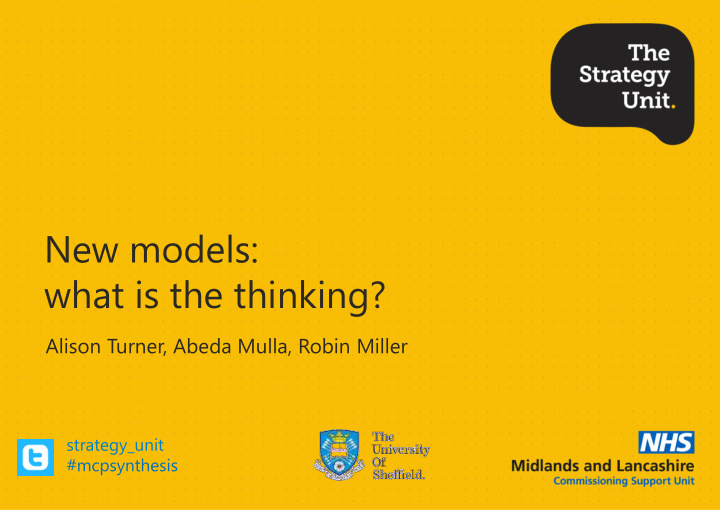



New models: what is the thinking? Alison Turner, Abeda Mulla, Robin Miller strategy_unit #mcpsynthesis
Multispecialty Community Providers “The MCP care model operates at four different levels: • at the whole population level, the MCP aims to bend the curve of future healthcare demand. It aims to address the wider determinants of health and tackle inequalities. It builds social capital by mobilising citizens, local employers and the voluntary sector; • for people with self -limiting conditions, the MCP helps build and forms part of a more coherent and effective local network of urgent care; • for people with ongoing care needs, it provides a broader range of services in the community that are more joined-up between primary, community, social and acute care services, and between physical and mental health, including for some, integrated personal commissioning (IPC) and personal health budgets; and • for small numbers of patients with very high needs and costs, it delivers an ‘extensive care’ service.” https://www.england.nhs.uk/wp-content/uploads/2016/07/mcp-care-model-frmwrk.pdf 2
About the project Aims: Objectives : To provide decision makers in health and articulate programme theories by • • social care with a practical evidence base mapping logic models/key documents, relating to the MCP model of care. prioritising theories for investigation; To develop a “blueprint” which articulates • identify sources of evidence to test • how and why MCP models work. programme theories; To support decision makers in a range of • appraise, extract and analyse evidence; • settings, by: develop the synthesis, producing a • Supporting the required local “blueprint”; evaluation of the MCP sites; consult with key stakeholders to validate • Enabling shared learning for the findings and test applicability to different design and delivery of the MCPs in a timely way; contexts; Informing policymakers of the “active finalise the synthesis, incorporating • ingredients” for successful new stakeholder feedback; models of care. disseminate findings. • 3
Review questions What are the foremost theories of change inherent within the MCP model of care? What seem to be the “active ingredients” which should inform design of MCP models of care? What are the social and cultural conditions which influence (enabling and blocking) change within MCP models of care and how do these mechanisms operate in different contexts? What are the key knowledge gaps and uncertainties in relation to the design, implementation and evaluation of MCP models of care? 4
Our approach A realist review seeks to understand and explain what works for whom under what circumstances Specifically, we are looking at a New Model of Care (MCP) to identify under what circumstances MCPs are more or less likely to deliver the benefits that are claimed for them (the Quadruple Aim) Our research will help to improve future health service delivery and lessons learned may also apply to other new models of care Our approach will help us to understand why an intervention or model seems to work (or not) in different contexts 5
Realist methods are being increasingly used… Example Improving skills and care standards in the support workforce for older people: a realist synthesis of workforce development interventions ‘What works’ in workforce development for the older persons’ support workforce: Making it real to the work of the support worker. • Paying attention to the individual • Tapping into support workers’ motivations • Joining things up around workforce • Co-design • Journeying together • Taking a planned approach in workforce • Spreading the impacts of workforce development across organisations • https://www.journalslibrary.nihr.ac.uk/hsdr/hsdr04120/#/abstract 6
Discussion on tables What works for whom under what circumstances Considering the perspectives of: patients, communities, practitioners, providers, commissioners What aspects of the MCP model might work? Why? Conversely, what aspects of the MCP model might not work? Why? 7
A framework for understanding whole system change a. NHS England 2015. The 10 enablers of transformation in “THE FORWARD VIEW INTO ACTION. New Care Models: support for the vanguards” https://www.england.nhs.uk/wp- content/uploads/2015/12/acc-uec-support- package.pdf b. NHS England 2016. MCP Framework: working document shared in confidence June 2016 c. WHO 2016. Framework on integrated, people- centred health services http://apps.who.int/gb/ebwha/pdf_files/WHA69 /A69_39-en.pdf?ua=1 d. Fillingham and Weir 2014 System leadership: Lessons and learning from AQuA’s Integrated Care Discovery Communities. Figure 2: Framework AQuA’s Integration System http://www.kingsfund.org.uk/publications/syste m-leadership e. NHS England 2016. The multispecialty community provider (MCP) emerging care model and contract framework https://www.england.nhs.uk/wp- content/uploads/2016/07/mcp-care-model- frmwrk.pdf 8
Programme theory components Programme theory reviews Programme theory maps R1 Community based coordinated care is M1 Collective responsibility improves quality more accessible and safety outcomes M2 Multidisciplinary teams provide R2 Place-based contracting and payment continuity for patients with LTCs/complex systems incentivise shared accountability needs M3 Engaged and trained staff expedite R3 Fostering relational behaviours builds cultural change resilience within communities M4 System learning embeds and sustains transformational change M5: Proactive population health is dependent on shared and linked data 9
More information Project information: https://www.journalslibrary.nihr.ac.uk/programmes/hsdr/157715/#/ Wordpress site: https://mcpsynthesis.wordpress.com/ Protocol: https://systematicreviewsjournal.biomedcentral.com/articles/10.1186/s13643-016-0346-x 10
This project is funded by the National Institute for Health Research, Health Services and Delivery Research Programme (project number 15/77/15). The views and opinions expressed therein are those of the authors and do not necessarily reflect those of the Health Services and Delivery Research Programme, NIHR, NHS or the Department of Health. 11
Recommend
More recommend